How to Buy a Cheap Gaming Laptop: 7 Essential Tips
You don't have to put a hole in your savings account to play games like Rise of the Tomb Raider or Final Fantasy XV on a laptop. In fact, you could dive deep into the world of VR with an HTC Vive or Oculus Rift on a gaming laptop that's under $1,000.
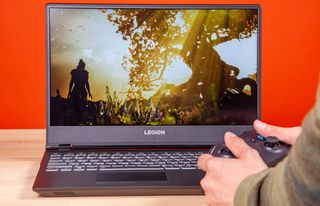
However, to get powerful specs at a low price, you do have to make some sacrifices on other key components. To avoid any buyer's remorse when getting a budget system, check out the tips and general advice below.
Quick Tips
- Know what you want to play. You don't need a discrete graphics card to run games like Overwatch or Hollow Knight. An integrated GPU will be just fine for a surprising amount of PC games.
- Get a 15-inch system. 15-inch laptops straddle the fence between portable and powerful; plus, they're more common at $1,000 and under.
- Don't settle for a low-res display. You can get that 1920 x 1080 screen even on a budget.
- Whether you're going cheap or all out, avoid touch screens. All they do is hike up the price.
- You'll need at least a GTX 1050 Ti for high-end VR. Thanks to the Oculus' Asynchronous Spacewarp technology, you can theoretically play in VR with an Nvidia GeForce GTX 1050 Ti. However, Microsoft's Mixed Reality headsets work well with integrated and entry-level GPUs.
- Get an SSD. Because you're sacrificing some power for your budget, you should aim for speed over memory.
- Get at least an Intel Core i5-7300HQ processor. With this CPU, you'll get solid and affordable performance.
Size: Power vs. Portability
Nearly every size of gaming laptop is available for less than $1,000. Keep in mind that the bigger they are, the more powerful they are, and vice versa (at least in most cases).
Most powerful, least portable (17-18 inches): With more size, comes more power, which really jacks up the price. This makes finding a reasonably priced 17-inch system somewhat difficult. But it's not impossible, as Dell has shown in its new G3 Gaming line with the G3 17 (starting at $799). That power will sacrifice some portability, however, because 17 and 18-inch laptops are heavier and use up a lot more battery power.
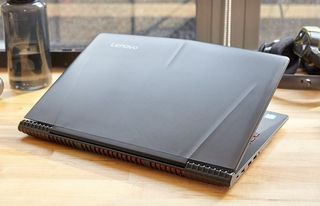
Moderately powerful & portable (15 inches)
: Offering a solid mix of portability and power, 15-inch laptops are typically the most popular size for gaming laptops. Not only are they usually cheaper, but they also tend to have more battery life than their larger cousins.
Stay in the know with Laptop Mag
Get our in-depth reviews, helpful tips, great deals, and the biggest news stories delivered to your inbox.
MORE: Best and Worst Laptop Gaming Brands
Least powerful, most portable (13-14 inches): While you can find 13 and 14-inch gaming laptops, they tend to be extremely expensive due to their extreme portability and typically long battery lives. However, they also tend to be less powerful than larger systems.
Graphics
The graphics card (GPU) brings life to the games you play, quite literally. The GPU sends the images directly to your display, and the images' appearance depends on the power of the graphics card and how much VRAM (video memory) it has.
Many gamers prize discrete GPUs, but these chips aren't always necessary to get great gaming performance. The GPUs listed below are those you'll likely find that fit within a sub-$1,000 budget.
Non-Gaming Laptops
- Integrated graphics: You may want to think twice before you blow money on that gaming laptop with a discrete GPU. An Intel UHD 620 GPU can run games like League of Legends, BioShock Infinite, MGS V: Phantom Pain and more. If those are the type of games you play, you can get a laptop that's well within your budget with better all-around specs.
- Nvidia MX150: If you want to play more graphically taxing titles, you still don't need to jump into Nvidia's 10-series just yet, as the company's mobile chips can handle quite a bit. You can play games like Grand Theft Auto V (High) and The Witcher 3: The Wild Hunt (Medium) at a smooth 30 frames per second. The result won't be perfect, but if all you care about is playing the big AAA titles, then the Nvidia MX150 will suffice.
Entry-Level Gaming
- Nvidia GeForce GTX 1050: Nvidia's GTX 1050 GPU is a 10-series chip, found in most entry-level gaming laptops. With that chip, you can run games like Rise of the Tomb Raider and Hellblade: Senua's Sacrifice on High settings and get some decent frame rates.
- Nvidia Max-Q design: Nvidia works closely with specific laptop companies to create slimmer and quieter versions of the GTX 1050, 1050 Ti and 1060. With a Max-Q, you'll get a lighter laptop that lacks those blaring fans, but it won't be as powerful as the original version. Max-Qs are a little rare in sub-$1,000 laptops, but one was featured in the Dell Inspiron 15 7000 Gaming laptop. You can also check out our more-comprehensive breakdown of Max-Q here.

- AMD Radeon RX 500X Series: AMD just launched its 500X series this past April, so stay tuned for our upcoming tests to see how well these chips stack up against Nvidia's GPUs in sub-$1,000 gaming notebooks.
VR on a Budget
- Nvidia GeForce GTX 1050 Ti: Now, you've entered the world of VR — well, technically. Due to Oculus' Asynchronous Spacewarp technology, you should, for all intents and purposes, be able to play in VR on a 1050 Ti, though your results may vary. If you're dead set on playing in VR on a cheap system, you'll want to check out a Microsoft Mixed Reality headset from Acer or HP. Otherwise, you can play games like Assassin's Creed Origins and Final Fantasy XV on High settings and get modest frame rates.
- Nvidia GeForce GTX 1060: You shouldn't have any trouble playing in VR with this bad boy. The GTX 1060 is definitely a top-of-the-line GPU for budget gaming laptops. It's also somewhat of a rare find for less than $1,000, but it can be had at that price in notebooks such as the MSI GV62 8RE. With this investment, you'll be able to enjoy the crisp and smooth visuals from Rise of the Tomb Raider (Very High) and Hellblade: Senua's Sacrifice (High), getting nearly 60 frames per second.
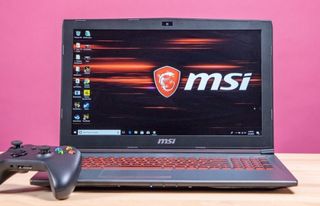
Display
Usually, the first thing sacrificed in a budget gaming laptop is the display, but here are a few tips to help you find the best screen in your budget.
Resolution: Despite hunting for an entry-level gaming laptop, you shouldn't lower yourself to using a pitiful 1366 x 768 resolution. Aim for that 1920 x 1080 screen! Unfortunately, you'll be hard-pressed to find a laptop with a QHD (2560 x 1440) or 4K (3840 x 2160) panel selling for under $1,000.
Touch Screens: You won't find many sub-$1,000 gaming laptops with touch screen displays, but they do exist. While we recommend against getting a touch screen, due to the price jump, if you're in desperate need of one, we suggest getting the Acer Nitro 5 Spin. It has a pretty good display, especially compared to other cheap gaming laptops.

Matte or Glossy
: There's not really a price difference between the two, so this decision is more about personal preference. However, if you plan on gaming in well-lit spaces, then you might want to think about getting a matte screen, as it won't reflect as much light. But if you usually game in the dark, you may enjoy the vivid colors of a glossy panel much more.
Audio
You might find it a little difficult to get quality audio in a cheap gaming laptop. But there are a few things to keep in mind if you prefer listening to epic battle cries and sword slashes through speakers instead of a headset. More often than not, your laptop's preinstalled audio software will enhance whatever discount speakers are packed into your laptop.
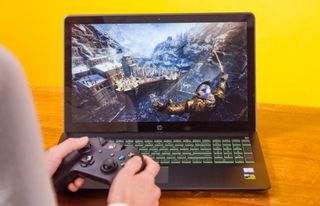
For example, HP laptops usually come with Bang & Olufsen's audio software, as featured in the Pavilion Power 15t, which gave a boost in volume to its weak speakers. Lenovo laptops also come with some iteration of Dolby Audio, which can be found in the Legion Y520 as well as some Acers, like the Nitro 5 Spin.
Keyboards
Keyboards and touchpads also often face the chopping block on cheaper gaming notebooks.

On sub-$1,000 gaming laptops, the keyboards tend to look and feel cheap, but we'll try to get you through the other side unscathed with these tips:
- Try it yourself: Stores like Walmart and Best Buy usually put laptops on display, so we recommend testing the keyboard out for yourself, because companies don't typically advertise measures like key travel or actuation force.
- Key travel: This measurement determines exactly how far the keys physically travel to hit the bottom of the key switch. We typically look for key travel between 1.5 and 2.0 millimeters, as keys with that kind of travel are generally more comfortable and pleasantly clicky.
- Actuation: Generally, you don't want a squishy keyboard that will slow you down when you type or spam commands, which is why our reviews look at the amount of physical force you need to press a key. We've found that we are comfortable with a minimum of 60 grams of actuation force.
- Software: You might not find a cheap gaming laptop with more than one setting for backlighting, but getting one with macros software is pretty important. MSI offers one of the best gaming utilities, called Dragon Center, which you can use to monitor the system's status, customize the fans, change the display color temperature and more.
- Anti-ghosting: This feature is important for fighting gamers like me who tend to mash all the buttons to win in Dragon Ball FighterZ. Anti-ghosting basically determines which keys can be pressed and registered in-game simultaneously.
- Don't use the touchpad: Do yourself a favor and get a cheap gaming mouse, because it's incredibly painful to game on a touchpad. You can check our list of the best cheap gaming mice here.
CPU and RAM
The CPU focuses less on your laptop's visuals and more on the machine's actual performance. It also affects every other program inside your computer. And it's important to keep in mind that if your CPU isn't strong enough, it may bottleneck your GPU. Here are a few tips that'll help you pick out the right CPU and RAM. But for more in-depth info, check out our guide to Intel processors.
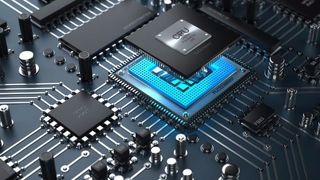
- Stick with Intel: Finding an AMD processor in a gaming laptop is like finding a Mew on your front lawn (in other words, very rare).
- Go for a Core i5: Anything lower than a Core i5 will kill your performance, and anything higher might kill your wallet. It is possible to get a Core i7 for under $1,000, but be mindful of the chip's generation, number of cores and clock speed.
- Keep 7th-Gen cores in mind: New things are great. They can also be pretty expensive. So, while Intel's new Coffee Lake (8th Gen) processors are the new standard, it's perfectly fine to go with a 7th Gen. You can identify the generation on the first number listed after the hyphen: An Intel Core i5-(7)300HQ is a 7th Gen, for example, while an Intel Core i5-(8)300H is 8th Gen.
- Quad-core is a necessity, but six-core is affordable: The minimum processor we recommend is actually an Intel Core i5-7300HQ, which has four cores. At the end of 7th Gen CPUs, you can see the suffixes, like "HQ" or "HK," that indicate the number of cores the chip has. (HK is technically better, because it means you can overclock the chip). 8th Gen i5 processors with an "H" have four cores, while in 8th Gen i7 processors, the "U" suffix indicates four cores. The "H" on an 8th Gen i7 CPU means that the chip has six cores. The Dell G3 15 Gaming has a config that comes with a Core i7-8750H and sells for under $1,000.
- Look at the clock speed: The number at the beginning of every processor name, like "2.5-GHz," tells you the speed of each core in the chip. Don't confuse this with overall power or speed, as a quad-core processor with lower clock speed could handle tasks better than a dual-core processor with higher clock speed. This is due to the number of cores running tasks at once. Some processors can be overclocked as well, via Intel's Extreme Tuning Utility.
- Don't go below 8GB: This is the bare minimum of RAM in order to handle some intensive games, and while 16GB gets you into a nice safety net, focusing on the CPU or GPU is more important.
Storage
Solid state drives are the standard for storage nowadays, as they are incredibly fast compared to regular mechanical hard drives. Even cheap gaming laptops have SSD options. However, if your budget's really tight, you have to decide whether having lots of storage (HDD) trumps having speed (SSD).
MORE: Best Hard Drive Speed
As a rule, SSDs deliver fast boot times on your computer and the games you run, but these drives can get expensive depending on how much space you want. Ideally, we recommend 256GB, but depending on the laptop brand, the price difference between a 128GB and 256GB drive is significant. Meanwhile, an HDD will offer plenty of room to store all the games you want and other big files, but it will load a lot slower than an SSD. Ultimately, we suggest prioritizing the SSD, because the faster boot time is well worth the sacrifice in space.
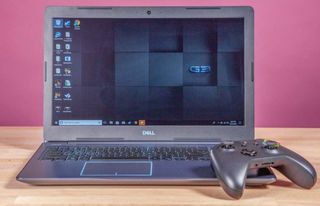
However, ideally, you'd want to get a laptop that has both drives, like the Dell G3 15. With two types of drives, you could have your OS on the SSD, giving you fast startup times, while you store the bulk of your games on the HDD.
Affordable Brands
You have an idea of what specs you want and how much you're willing to spend, but which company can you trust to deliver the best budget gaming laptop? We have some guaranteed heavy hitters under $1,000 here, but we also have a few tips to help you pick a brand.
- Acer: Acer has some decent, cheap gaming notebooks, like the Nitro 5 and its versatile brother, the Nitro 5 Spin. The company also sells the Predator Helios 300, which starts at $999 and comes with a GTX 1060; it’s one of the better affordable gaming laptops we’ve reviewed. Acer offers free shipping and 24/7 tech support on both its one-year limited warranty plan with the Nitro line and the two-year warranty with the Predator line.
- Asus: While Asus is known for its Republic of Gamers brand, the company recently launched an affordable gaming laptop outside of that series, with the TUF Gaming FX504, which comes with one of my favorite keyboards. Asus also provides a one-year international warranty with accidental-damage coverage and a 30-day zero-bright dot protection (guaranteeing a product free of dead pixels) with 24/7 tech support.
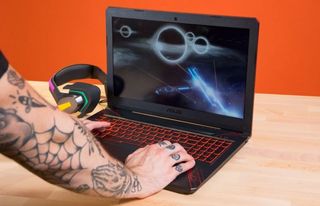
- Dell: While Alienware is busy making super-luxurious and high-end gaming laptops, the Dell side keeps budgeted consumers in mind. With the recent launch of the G series line with laptops like the G3 15 Gaming, Dell provides decently powerful laptops for a relatively cheap price. However, the company also has some black sheep, like the Inspiron 15 5000 Gaming, which lasted only 1 hour and 53 minutes on our battery test. Dell offers a one-year limited warranty with free shipping on the company's laptops.
- HP: While HP's higher-tier Omen series can get quite pricey, the Omen 15 actually starts at $999.99, and it's our best overall budget gaming laptop. HP also has a cheaper laptop, the Pavilion Power 15t, which offers some solid performance. HP's one-year limited warranty includes free shipping as well.
- Lenovo: Despite the low prices, Lenovo's Legion line looks absolutely prestigious, the Legion Y530 in particular. Yet, the same could be said for Legion Y520's epic armored Batman look. Lenovo usually ships its laptops with a one-year limited warranty that includes free parts and labor, as well as 24/7 tech support.
- MSI: When MSI isn't pumping out $3,999 monsters like the GT75 Titan, the company makes some affordable gaming laptops, like the GL62M 7REX, which sports a wildly colorful display, and the GV62 8RE, which has great performance. As mentioned earlier, MSI has one of the best gaming utilities currently available, the Dragon Center, giving the company a considerable advantage over other brands. MSI also includes a two-year limited warranty and is the only company that offers free accidental-damage protection.
Credit: Laptop Mag

Rami Tabari is an Editor for Laptop Mag. He reviews every shape and form of a laptop as well as all sorts of cool tech. You can find him sitting at his desk surrounded by a hoarder's dream of laptops, and when he navigates his way out to civilization, you can catch him watching really bad anime or playing some kind of painfully difficult game. He’s the best at every game and he just doesn’t lose. That’s why you’ll occasionally catch his byline attached to the latest Souls-like challenge.
